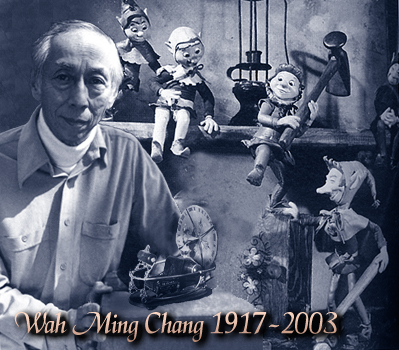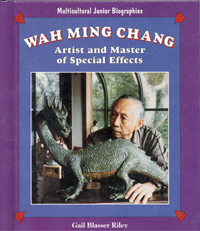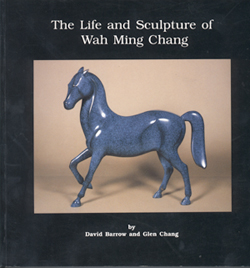 |
Wah Ming Chang was born on August 2, 1917 in Honolulu Hawaii. His family moved to San Francisco in 1919 and his parents soon opened the HoHo Tea Room on Sutter St. Wah's mother, Fai Sue Chang was herself a talented artist and had graduated from the California School of Arts and Crafts. Art supplies were always available and soon Wah began to put them to good use as well. The tea room became a haven for the art community. Wah would sit quietly in the tea room sketching and would be encouraged by the visiting artists. At the age of seven, Blanding Sloan, a well known artist, took interest in young Wah's work. Sloan brought Wah into his studio where he taught his students how to do copper etchings. One day after Sloan and the other students had left, Wah created his first etching, and it was a success. Wah and Sloan became very close, Wah was given complete freedom in respect to subject, medium and style regarding his art projects. It was Blanding Sloan who first introduced Wah to the art of puppet making, a talent which would have a lasting influence in Wah's life. Wah was the subject of numerous newspaper articles and radio appearances. By the age of nine he had his own one man show at an art gallery in downtown San Francisco. Wah had become a very well known artist. Wah's life takes a new direction when at the age of eleven his mother dies unexpectedly. Wah's father decides to go to Europe to get away from his loss, without Wah. Wah is taken in by Blanding Sloan and his wife Mildred Taylor as his guardians. Wah received a scholarship to attend the Peninsula School of Creative Education in Menlo Park. While at the school, Wah teamed up with one of the other students and the two then created and performed many puppet shows for their classmates. Prior to leaving the school, students were invited to paint murals on the walls. The murals would remain until the following class which would have their turn. Wah's mural was allowed to remain longer than the one year period. After finishing at the Peninsula School, Wah moved into a trailer at the Hollywood home of Blanding and his wife who now had their own four year old son. At age sixteen, while attending High School, Wah was given the responsibility of creating sets for shows at the Hollywood Bowl. In 1936, Texas born Blanding Sloan was put in charge of lighting and appointed director of the Cavalcade of Texas, one of many attractions planned for " The Texas Centennial Fair". Wah, now finished with high school, joins Sloan as a staff artist. While working on the Cavalcade, Wah met and worked with Glennella (Glen) Taylor. Wah stayed in Texas after the Cavalcade ended and tried to start a business with a friend. The business didn't succeed partly due to the depression during the 30's. Wah returned to Hollywood and soon heard form his father who had remarried and was on his way to China. Wah met with his father in Honolulu and stayed for a year before returning to San Francisco at the request of a friend who wanted him to work at the San Francisco World's Fair. Among the work Wah did during the year was making his first stop motion film, his animation skills were self taught. 1939 saw the release of Disney's Snow White and the Seven Dwarves. Disney was about to begin it's second animated film Pinocchio and Wah applied for work. At age 21, Wah was the youngest member of Disney's Effects and Model Department. Wah was making wooden models of the characters so the animators could study body movements. During Wah's summer vacation he went to Indiana to pick up a car he had bought and drove to Texas to visit Glen. Shortly after his return to Disney, Wah was hospitalized with what was thought to be the flu. In actuality, Wah had come down with Polio. It would be at least ten years before medication would be developed to prevent and treat this debilitating disease. After twenty-one days in the hospital and loss of use of his legs, Wah was released to a sanitarium to learn to walk again. On one of his visits to see Wah, Blanding Sloan and Wah developed a plan to help with Wah's rehabilitation. A work bench and art supplies were brought in and each day Wah would use his wheelchair to convey himself to the work bench and work at creating art projects. After a year Wah had improved to where he could walk again with the use of leg braces and return to live with Blanding and his wife. Glen visited California in the summer of 1941 and by the end of August she and Wah were engaged to be married. Glen returned to her job in Texas and the two were making wedding plans. December 7, 1941 dramatically changed their plans as travel within the country became increasingly difficult. They decided to marry in Texas as California law at the time forbade a Caucasian and a Chinese to marry. They then returned to California and got their own apartment. Wah was hired by George Pal where he worked on the Puppetoons and here he met Gene Warren. After working for George Pal and later John Sutherland, he and Glen started their own studio in 1945 and produced educational films. Blanding Sloan teamed up with the Changs to do an animated Anti-A-Bomb film titled The Way of Peace. The film debuted at Constitution Hall in Washington DC with President Truman and Albert Einstein in attendance Work slowed up for the Changs company so Wah joined with Gene Warren and formed Centaur, an effects company. The company worked on several projects, from commercials, costumes, props, and even a toy line. In 1956, Wah, Gene and Tim Barr started a new company, Project Unlimited. It was through this company that Wah and Gene would work on the projects for which they are best remembered. The first major work would be for George Pal's production of tom thumb in 1958. George Pal had finished principle photography on tom thumb and was looking for someone to do the stop motion sequences for the film. One company submitted a budget which was too high and George had looked for Wah and Gene's company Centaur but by then they had closed that company. The story goes that George met Gene walking down the street one day and they struck a deal then and there.
Project Unlimited eventually also closed its doors, but Wah continued to keep busy. During the years that followed he worked on various other projects as an independent artist. During this time he created several props and costumes for the Star Trek television series. Among them are: the federation communicator, tricorder, hand phaser and the Salt Creature. Wah was also created masks for The King and I starring Yul Brynner and the massive headdress worn by Elizabeth Taylor in Cleopatra.
After twenty-five years, the Changs decided on a major change in their lifestyle. In 1970 they packed up their home in Altadena and moved to northern California where Wah designed and built their new home. Wah now concentrated on creating sculpture of wildlife. In 1987 Hank Ketcham commissioned Wah to sculpt a life-size bronze sculpture of his creation, Dennis the Menace. Four sculptures were eventually done, one went to Ketcham's own garden, one in his studio, one at the Arnold Palmer Children's Hospital and the forth was placed in Dennis the Menace Park in Monterey, California. In 1992 Wah experienced post polio syndrome as a result of his earlier bout with polio. It was now necessary for Wah to use a walker to get around and Glen was now doing more of the business dealings regarding his bronze sculptures. A few years ago Glen passed away and today Wah has a live in helper who takes care of the daily tasks. Now at age 83 he is still solving problems with creativity. He gets around the house with the use of his walker which he has modified by the addition of a metal basket in which he has on hand paper, pens, his incoming and out going correspondence and his cordless telephone, in essence his own portable office. In 2000 Wah had a showing at his local art gallery of a photographic study of many of his accomplishments ranging from his early years up to his sculptures. Although he doesn't have the strength and stamina to do his sculptures any longer, he has discovered the PC. On our recent visit with him in January this year he showed my wife and I his current art projects he has created using his PC. We've not seen the end of the creative endeavors of this great talent yet! *** A showing of Wah Ming Chang and Tyrus Wong's work was on display from July 15- December 28, 2003 at The Chinese Historical Society of America in San Franciso. Wah Ming Chang passes away at 10:15 a.m. on December 22, 2003. Virginia Park, Wah's caretaker and companion for the last seven years of Wah's life, said in reference to his relationship with his wife Glen "It was a love story that never actually ended." "Several times last night he said, 'Glen's playing with my toe.' It was a little signal they had when she was alive. At 6:30 in the morning, he said it again. A few hours later, he was gone." Details on the memorial service held for Wah Ming Chang
|
|||||||
To
Send Us E-mail
Click
Here
If
you entered this page from other than our main page
and you are not in a frame set (no page directory on the left)
Click Here
The
Time Machine Project © 1998 Don Coleman
Web Site © 1999 Don Coleman
Web site created by Don Coleman
3727 W. Magnolia Blvd. #240
Burbank, CA 91505




